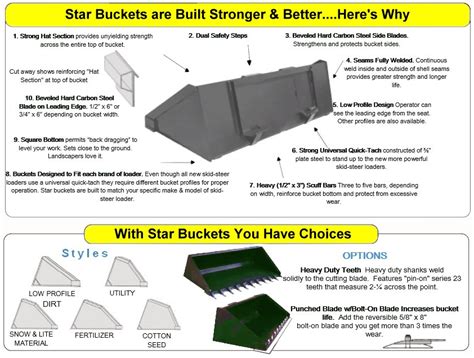cubic yard per skid steer bucket Generally, standard skid steer buckets range between 6 cubic yards and 7.5 cubic yards, with more specialized sizes (for example, demolition buckets) ranging up to 12 cubic yards. This translates to an approximate capacity of 8 cubic feet .
The latest generation of KAISER S10 and S12 mobile walking excavators again sets benchmarks in terms of performance and efficiency. Evolution of the technology leader. Development of the .
0 · standard skid steer bucket size
1 · smooth bucket for skid steer
2 · skid steer bucket volume chart
3 · skid steer bucket capacity chart
4 · skid steer attachments for dirt
5 · paladin bucket capacity chart
6 · bobcat bucket size yards
7 · 2 yard skid steer bucket
This pervasive myth that paints Asian women as either gold diggers or quiet and polite is perhaps the reason for a lot of the casual racism I’ve experienced—along with the assumption that I .

standard skid steer bucket size
Learn how to calculate the volume and rated capacity of a bucket using the SAE standard angle of repose and a simple grid method. See step-by-step instructions and examples for wheel loader and hydraulic excavator buckets. To find your skid steer bucket’s capacity, use this formula: Bucket Capacity (in .Learn how to calculate the volume and rated capacity of a bucket using the SAE standard angle of repose and a simple grid method. See step-by-step instructions and examples for wheel loader and hydraulic excavator buckets. To find your skid steer bucket’s capacity, use this formula: Bucket Capacity (in cubic yards) = Bucket Width (in feet) x Bucket Depth (in feet) x Bucket Height (in feet) / 27. This will estimate how much material it can carry.
Learn how to choose the right skid steer bucket size for different materials and jobs. See examples of calculations for cubic feet and weight of buckets. Generally, standard skid steer buckets range between 6 cubic yards and 7.5 cubic yards, with more specialized sizes (for example, demolition buckets) ranging up to 12 cubic yards. This translates to an approximate capacity of 8 cubic feet .Find out how to match your skid steer bucket to your loader and common jobs with this online tool. Enter the material, bucket capacity, bucket weight and skid steer operating capacity to get the results.
From the brute force of rock buckets to the finesse of grapple attachments, the right bucket can turn your skid steer into a specialized machine. But choosing the optimal bucket involves considering factors beyond just the task at hand. A 72-inch skid steer bucket can typically hold approximately 0.7 to 1 cubic yards of material, depending on its design. How much gravel will a skid steer bucket hold? The amount of gravel a skid steer bucket can hold depends on its capacity.Learn how to choose the right skid steer bucket for your needs, from dirt, utility, snow, multi-purpose and specialty buckets. Find out what to look for in a high-quality bucket, such as steel grade, design, reinforcement and weight.What we're going to want you to do is take that heaped capacity number, then find a chart of the materials that you might be lifting and carrying, and look at the weight of those materials per cubic foot and figure out how much weight of material you're going to get inside of the bucket.
Convert Measurements to Cubic Yards: Convert all measurements to yards if they are not already in that unit. For example, If the measurements are in inches, divide each measurement by 36 to convert to yards.Learn how to calculate the volume and rated capacity of a bucket using the SAE standard angle of repose and a simple grid method. See step-by-step instructions and examples for wheel loader and hydraulic excavator buckets. To find your skid steer bucket’s capacity, use this formula: Bucket Capacity (in cubic yards) = Bucket Width (in feet) x Bucket Depth (in feet) x Bucket Height (in feet) / 27. This will estimate how much material it can carry.
Learn how to choose the right skid steer bucket size for different materials and jobs. See examples of calculations for cubic feet and weight of buckets. Generally, standard skid steer buckets range between 6 cubic yards and 7.5 cubic yards, with more specialized sizes (for example, demolition buckets) ranging up to 12 cubic yards. This translates to an approximate capacity of 8 cubic feet .
Find out how to match your skid steer bucket to your loader and common jobs with this online tool. Enter the material, bucket capacity, bucket weight and skid steer operating capacity to get the results.
From the brute force of rock buckets to the finesse of grapple attachments, the right bucket can turn your skid steer into a specialized machine. But choosing the optimal bucket involves considering factors beyond just the task at hand.

A 72-inch skid steer bucket can typically hold approximately 0.7 to 1 cubic yards of material, depending on its design. How much gravel will a skid steer bucket hold? The amount of gravel a skid steer bucket can hold depends on its capacity.
Learn how to choose the right skid steer bucket for your needs, from dirt, utility, snow, multi-purpose and specialty buckets. Find out what to look for in a high-quality bucket, such as steel grade, design, reinforcement and weight.What we're going to want you to do is take that heaped capacity number, then find a chart of the materials that you might be lifting and carrying, and look at the weight of those materials per cubic foot and figure out how much weight of material you're going to get inside of the bucket.
smooth bucket for skid steer

mini john deere skid steer
In his second NFL season, Trevon Diggs became one of the most dominant cornerbacks. He was first team All-Pro, but his Dallas Cowboys suffered a heartbreaking loss .
cubic yard per skid steer bucket|2 yard skid steer bucket